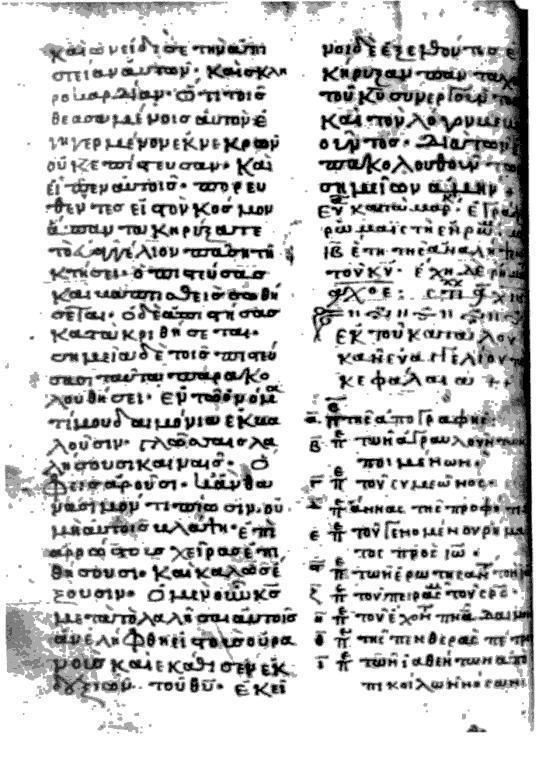Date 13th century Size 23.9 cm by 18.2 cm | ||
 | ||
Now at | ||
Minuscule 13 (in the Gregory-Aland numbering), ε 368 (Soden), is a Greek minuscule manuscript of the New Testament, on a parchment, dated to the 13th century. The manuscript is lacunose. The text of the manuscript is important for the textual critic. It has marginalia and was adapted for liturgical use.
Contents
Description
The codex contains the text of the four Gospels on 170 parchment leaves (23.9 cm by 18.2 cm), with some lacunae (Matt 1:1-2:20; 26:33-52; 27:26-28:9; Mark 1:20-45; John 16:19-17:11; 21:2-25). The text is written in two columns per page, 28-30 lines per page, in minuscule letters. According to Scrivener "it is not correctly written".
The text is divided according to the κεφαλαια (chapters), whose numbers are given at the margin, and their τιτλοι (titles of chapters) at the top of the pages. There is also another division according to the smaller Ammonian Sections (in Mark 234 sections, the last in 16:9). It has no references to the Eusebian Canons.
It contains tables of the κεφαλαια (tables of contents) before each Gospel, lectionary markings at the margin (for liturgical use), Synaxarion, Menologion, and subscriptions at the end of each Gospel. In subscriptions are given numbers of ρηματα, and numbers of στιχοι. According to subscriptions the Gospel of Matthew was written in Hebrew, Mark in Latin and Luke in Greek. The subscription states that Matthew was written in Hebrew eight years after our Lord’s Ascension, and contained 2522 ρηματα and 2560 στιχοι, Mark was written in Latin ten years after the Ascension with 1675 ρηματα and 1604 στιχοι, Luke in Greek fifteen years after with 3803 ρηματα and 2750 stichoi, and John thirty two years after with 1838 ρηματα.
According to Ferrar it has 1523 errors of itacisms and another errors, but not more than in other manuscripts of that time. Letter ο is frequently written for ω, ου is once written for υ (in Matthew 25:9).
The text of Adultery pericopa (John 7:53–8:11) follows after Luke 21:38. The text of Matthew 16:2b–3 (signs of the times) is omitted. Luke 22:43-44 (Christ's agony at Gethsemane) is placed after Matthew 26:39.
Text
The Greek text of the codex is a representative of the Caesarean text-type. It belongs to the textual family known as family 13, or Ferrar group. It was confirmed by the Claremont Profile Method. According to Kurt and Barbara Aland it agrees 150 times with the Byzantine text against the original, 31 times with original against the Byzantine, and 71 it agrees with both. It has also 54 independent or distinctive readings. The Alands placed text of the codex in Category III.
The manuscripts of the Ferrar group were derived from an uncial ancestor once located in southern Italy (Calabria) or Sicily in the 7th century.
In Matthew 1:16 it has the same textual reading as Codex Koridethi, the Curetonian Syriac, and rest of the manuscripts of the Ferrar Family.
In John 12:5 it reads διακοσιων for τριακοσιων along with other manuscripts of the family 13 and 1424;
History
It is believed the manuscript was written in Calabria or Sicilia. Currently the manuscript is dated by the INTF on palaeographical grounds to the 13th century. It was in private hands, and belonged to Archbishop of Reims Le Tellier (1671–1710) (along with codices 10, 11). It was used by Kuster in his edition of Mill's Novum Testamentum (Paris 6).
It was added to the list of the New Testament manuscripts by Wettstein, who gave it the number 13. This number is still in use.
It was examined and described by Wettstein, Griesbach, Birch, Paulin Martin, W. H. Ferrar, and J. Rendel Harris, Kirsopp Lake, and many other palaeographers and textual critics. C. R. Gregory saw the manuscript in 1884.
Griesbach highly esteemed the text of this manuscript.
It was collated in 1868 by W. H. Ferrar, and published posthumously by T. K. Abbott in the book A Collation of Four Important Manuscripts of the Gospels. Ferrar regarded codices 13, 69, 124, 346 as transcripts of the same archetype.
The codex is located now at the Bibliothèque nationale de France (Gr. 50) at Paris.
